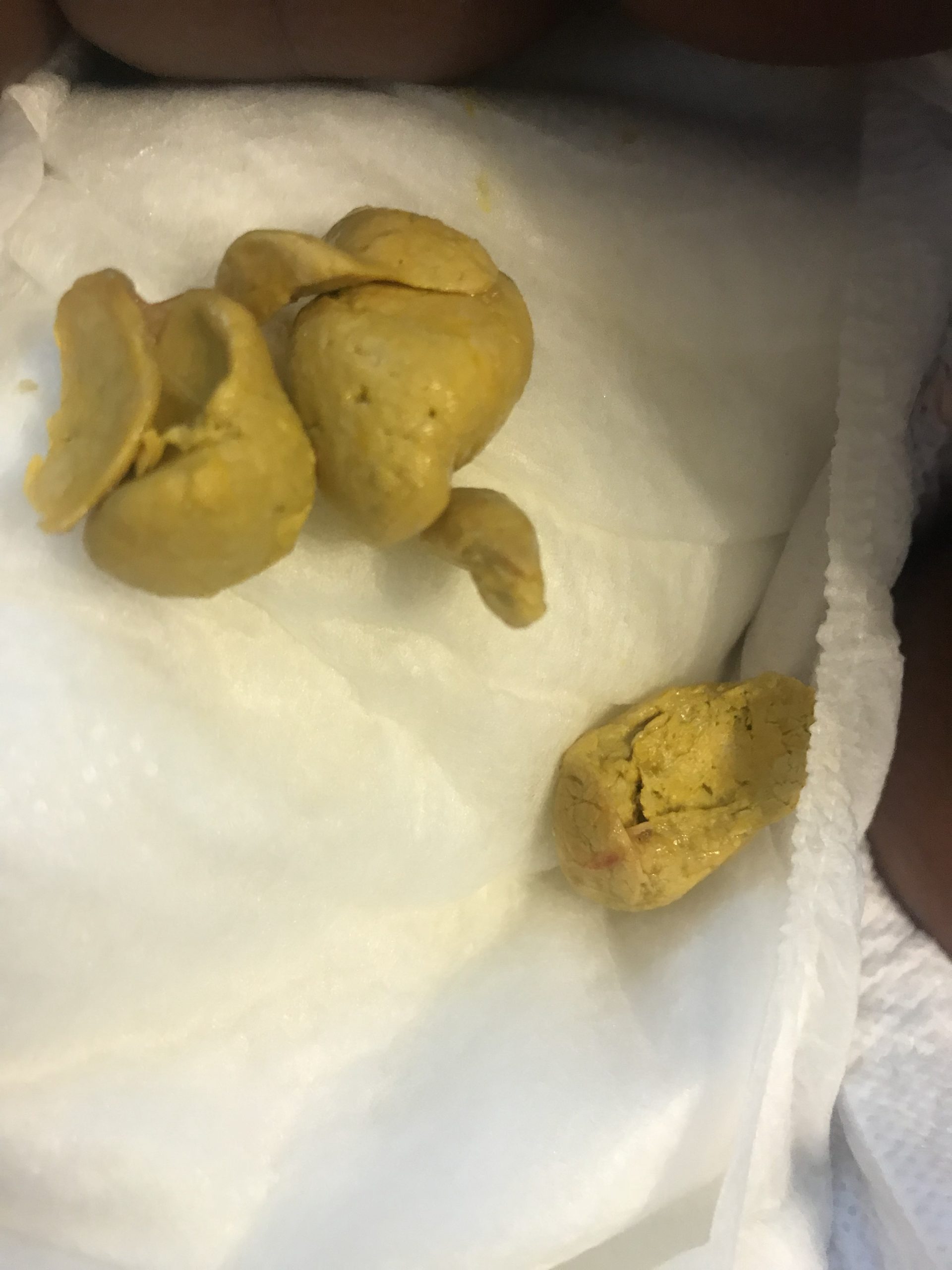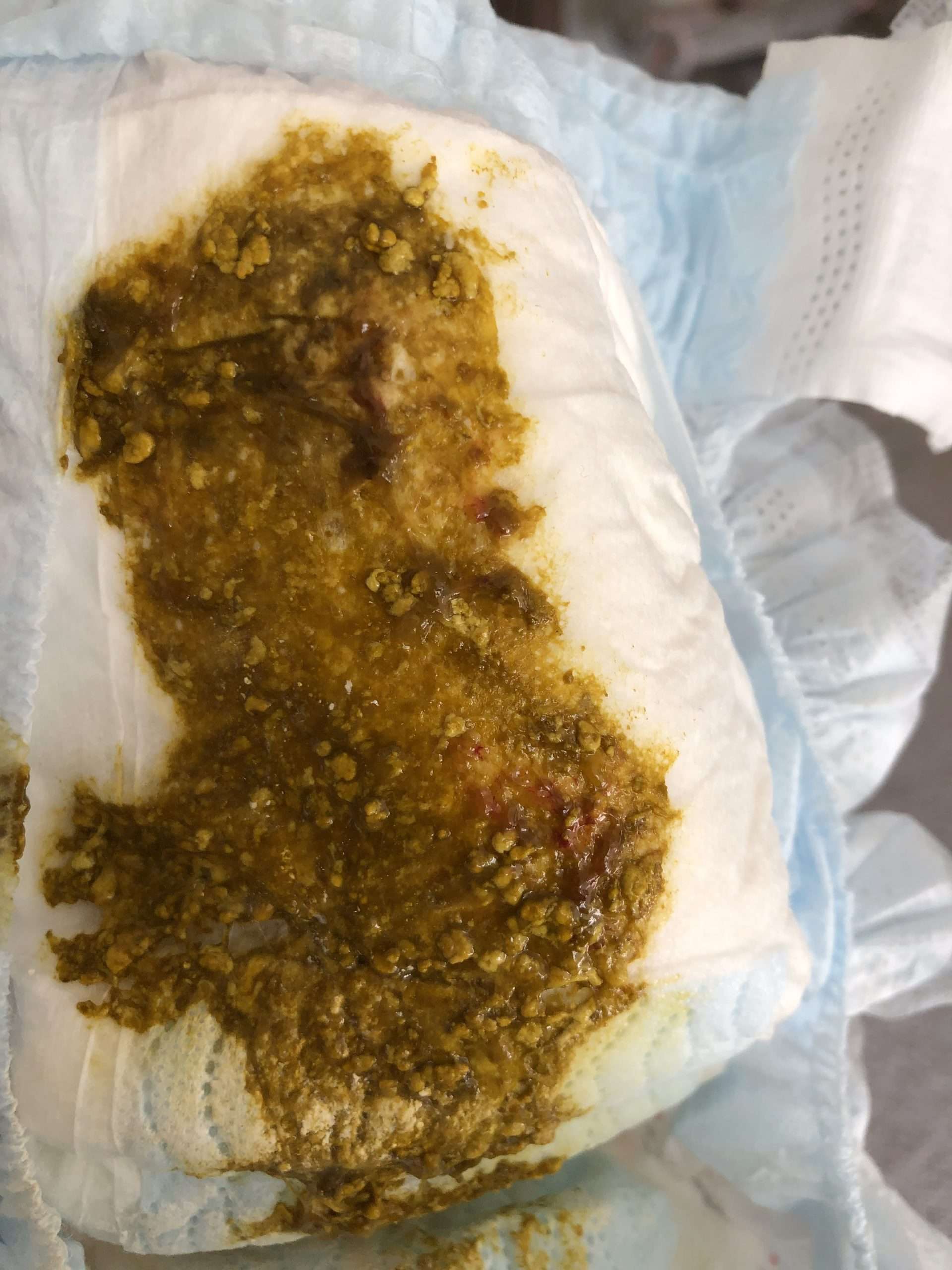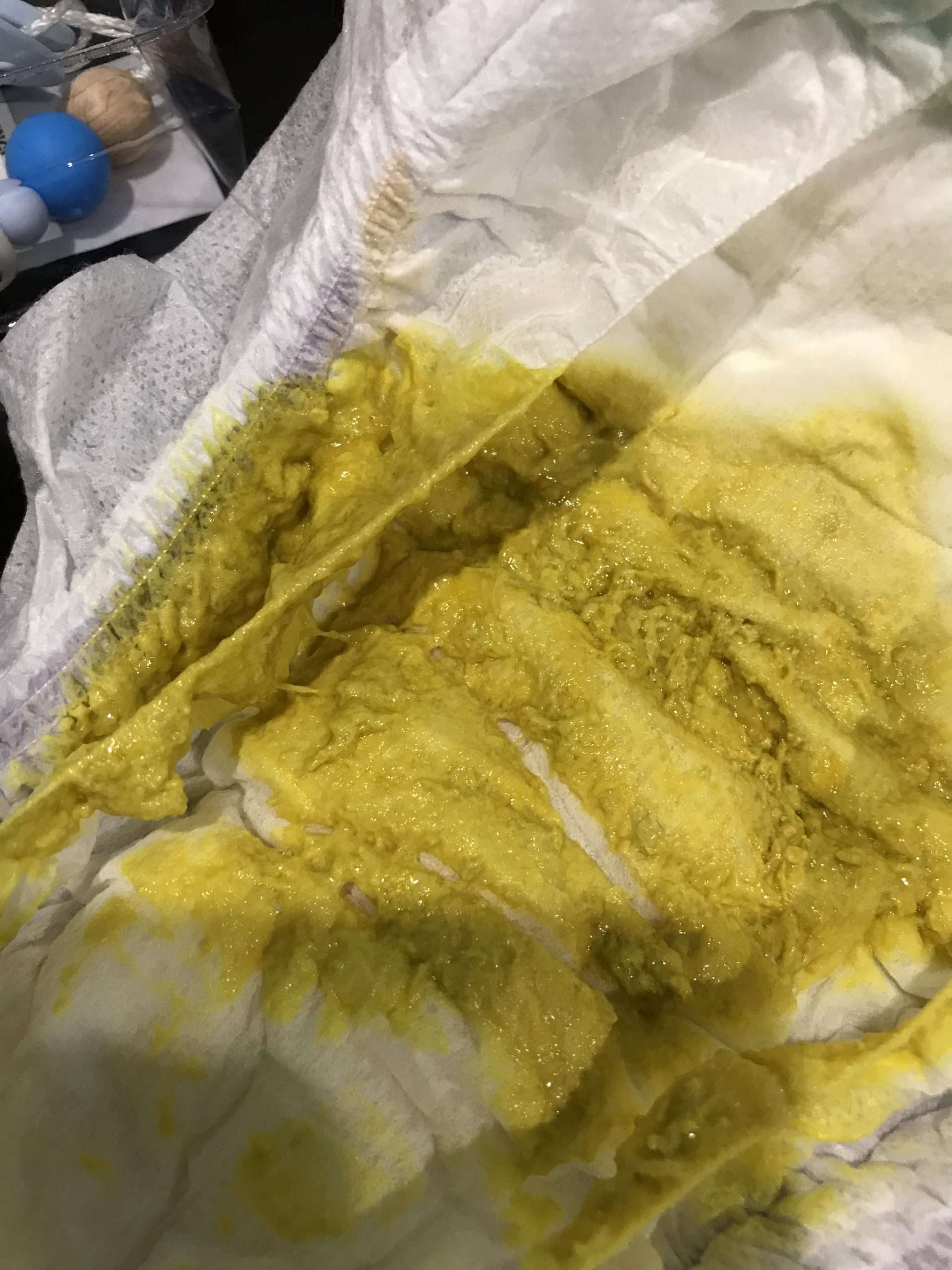Causes Of Acute Diarrhea
- Virus . An infection of the intestines from a virus is the most common cause.
- Bacteria . Less common cause. Diarrhea often contains streaks of blood.
- Giardia . More likely in child care center outbreaks.
- Antibiotic Diarrhea. Many antibiotics cause mild diarrhea. This is not an allergic reaction. Keep giving the antibiotic. Call your doctor if any serious symptoms occur.
- Serious Causes. Most bacterial diarrhea goes away on its own. A few can cause a severe large bowel infection . C. difficile is a serious cause that can occur after being on strong antibiotics.
- Serious Complication: Dehydration. This is the health problem where the body has lost too much fluid. .
Diarrhea In Breastfed Babies: How To Tell
- Diarrhea in a breastfed baby is sometimes hard to tell.
- Normal breastfed stools are loose . Stools are yellow, but sometimes can be green. The green color is from bile. Runny stools can even be bordered by a water ring. These are all normal stools.
- Breastfed babies often pass more than 6 stools per day. Until 2 months of age, they may pass a stool after each feeding. But, if stools suddenly increase in number and looseness, suspect diarrhea. If it lasts for 3 or more stools, the baby has diarrhea.
- If the stools contain mucus, blood or smell bad, this points to diarrhea.
- Other clues to diarrhea are poor eating, acting sick, or a fever.
Identifying What Your Stools Look Like
Recurring bouts of loose stools over several weeks or months can cause ulcers to form in your colon, which contributes to further diarrhea due to irritation.
In general, loose stools are generally yellow or green and they may appear watery. Mucus or streaks of blood might be a sign that you have a more serious case of diarrhea requiring immediate medical attention.
For example, the bloody stool is more common among children and older infants. If you notice streaks of blood mixed in with your stool or the appearance of black and tarry stools contact your doctor as soon as possible.
Watery diarrhea is more likely to lead to dehydration, which can be life-threatening if left untreated. You can recognize dehydration by noticing that youre urinating less often than usual, or that your urine is dark in colour.
Read Also: Why Does Salad Make Me Poop Immediately
Stay Out Of Extreme Heat
Try not to take your newborn or young infant outdoors if itâs very hot or humid. If you need to be outside, keep your baby in the shade and as cool as possible.
Babies can also overheat inside in a hot, stuffy room or car, or if theyâre all bundled up. Try to keep your baby comfortable and breastfeed and offer a bottle often to replace the fluids that theyâre losing.
Also Check: How Do You Test Your Gut Microbiome
How Can I Help Baby With Constipation Or Diarrhea

Keep your baby hydrated
Continue breastfeeding, as nursing can help keep your little one hydrated. If your baby is older and has started solids, you can also offer additional fluids such as water.
*If your baby is between 6 and 12 months, the only additional fluid that is recommended is water, and only a few extra ounces per day is needed.12
Being adequately hydrated can also help improve constipation as well.
If youâre still noticing signs of dehydration or constipation even with continued nursing, contact your childâs pediatrician.
Read more: Is Your Baby or Toddler Adequately Hydrated?
Be mindful of your own diet while breastfeeding
Occasionally babies will react to something in their motherâs breastmilk, and this may sometimes cause diarrhea or constipation.6 Certain foods in momâs diet can also affect the stool color, but this is normal!
If youâre concerned that your baby may be reacting to something in your diet, reach out to the Happy Baby Experts. Chat Now!
Read more: Is my baby reacting to something in my milk?
Inform babyâs healthcare provider
If diarrhea occurs and your baby is under 3 months old, or there is also blood, mucus, pus or continuous vomiting or if the diarrhea will not go away, contact your childâs pediatrician right away.
If your child is experiencing persistent constipation for 2 weeks or constipation is accompanied by fever, vomiting, blood in stool, swollen abdomen or weight loss, contact your little oneâs pediatrician.
You May Like: Who Sells Align Probiotic
What Color Should My Newborns Poops Be
Your babys poop might be brown, tan, green, yellow, or even have an orange tint. The color might change a little throughout the day or from day to day.
Babies who eat breast milk might have more bright yellow poop, like the color of mustard. While babies who eat formula tend to have dark yellow or tan-colored stools.
If your baby is taking vitamins with iron, their poop might be closer to a dark green color.
Some babies might have green, frothy stools. These pea soup looking poops can be a sign of foremilk-hindmilk imbalance.
When To Call The Doctor
Does your baby have yellow watery diarrhea, green diarrhea, brown diarrhea, or anything in between? Depending on the cause, these bowel movements may last between five and 14 days. You should call your pediatrician if your infant has any of the following symptoms.
- Signs of dehydration
- Mucus or foul odor in three or more diarrhea stools
- Blood in the stool
- Severe diarrhea while taking antibiotics
- Fever
Also Check: Does Peanut Butter Cause Indigestion
How Often Do Babies Poop
If your baby doesnt pass stool every day, this doesnt necessarily mean theres a problem. A newborn can have few bowel movements early on.
If youre breastfeeding, then your baby may only poop once a week when they get to the three- to six-week mark. If your baby is formula-fed, then you should see bowel movements occurring at least once a day. Anything less than this could indicate constipation, though some formula-fed babies dont poop every day, either.
Your baby will likely have a daily bowel movement once theyre on solids. Pooping more than once after each feeding at any stage could indicate diarrhea.
Know that changes in color, and even consistency, are normal during your babys first year of life. But its also important to monitor these changes in case you need to call your pediatrician.
Causes Of Recurrent Diarrhea
- Cow’s Milk Allergy. Can cause loose, slimy stools in babies. Can be blood-streaked. Starts within the first 2 months of life. Need to avoid cow’s milk formulas.
- Lactose Intolerance. Lactose is the sugar in milk. Many people cannot absorb lactose. The gut bacteria convert the lactose to gas. The main symptoms are a lot of gas, loose stools and stomach bloating. Onset usually at age 4 or 5. This most often runs in the family .
Also Check: Does Almond Milk Cause Gas Bloating
What Does Newborn Lamb Poop Look Like
lamb should pooppooplikepooppooplambpoopinglamb does
. Simply so, what does baby lamb poop look like?
The ideal consistency of lamb poop should look like a grenade. Then when they get older and the rumen kicks in they should look like skittles. Hiccup has pudding poop. It’s not liquidy but it’s not solid.
Also, how do you know when lamb is full? You can tell if they’ve been nursing by feeling their bellies. Most baby mammals that aren’t getting enough to eat have sunken bellies, aren’t active, and, as Ross said, the inside of their mouths will be cold. With our lambs, I keep them in a jug for 2-3 days.
Also asked, what does scours look like in lambs?
Signs in live sheep and goatsThey have a watery, whitish-yellow or greyish diarrhoea that is known as “white scours“. The umbilical cord is sometimes red and swollen. The back legs are dirty with droppings. Lambs/kids usually die as a result of dehydration.
How long do you bottle feed lambs?
As most lambs get a little milk every few minutes, when they are young feed them at least every 4 hours until they are at least a week old. Then every 6 hours. Feed them until they are 2 months old or even older.
When Theres No Poop Constipation
With all the variation in how often your baby poops, you may sometimes wonder how you can tell if your little one is constipated.
Constipation is more common after the introduction of solids, but it can occur in younger babies, too. Here are some typical signs of constipation:
-
In a newborn baby. Firm stools that come less than once a day.
-
In an older baby or toddler. Hard, compact stools that only come every three or four days.
-
In a baby or child of any age. Large, hard, and dry stools that are painful to pass. If thereâs blood on or in your childâs stools. If your child strains for more than 10 minutes without passing any stool at all.
Don’t Miss: Bloating After Ivf Egg Retrieval
What Should Baby Poop Look Like Anyway
A range of colors, textures, frequencies and volumes are considered normal. But there are some things to watch out for.
Baby poop is a source of great mystery and often, concern for many parents. Sometimes its green and mushy other times its yellow and seedy. What does it all mean? Baby poop is not like adult poop, said Dr. Katie Lockwood,M.D.,an attending physician at Childrens Hospital of Philadelphia. So there are lots of questions about it.
Thankfully, unraveling the meaning behind all those bizarre colors, textures and sizes is pretty straightforward. And most of the time, everything you see is perfectly normal .
For this guide, I spoke with three experts about what to expect from your babys stool from birth until she starts eating solids including whats normal, whats not and when to call the doctor.
You May Like: What Is The Best Medicine For Ibs
Baby Poop The Ultimate Guide

Baby poop is probably something you were expecting to deal with, but did anyone tell you how varied the contents of your little oneâs diapers could be? Runny or firm, black, green, or yellowâeven mucus in your babyâs poop can be part of the adventure. Those diaper changes are, of course, a regular part of your daily routine as a parent, but they can also help you keep an eye on your babyâs well-being. Learn what the color, consistency, and frequency of baby poop can tell you about your babyâs health and development.
Also Check: Can Salad Cause Gas
Black Thick Baby Poop
Thick, black stools at 3 months of age or older often indicate bleeding in the digestive tract, which can be dangerous for your baby. Contact your pediatrician. One thing to note: Iron supplements or iron-fortified formula can sometimes cause stool to turn dark brown or black, in which case theres no need to be concerned. Check with your doctor to be sure.
Is It Normal If My Newborns Poop Looks Watery
Another unique feature of newborns poop is its consistency. Theres a wide range of normal, including watery poop. After all, your baby doesnt have a fully mature digestive system and theyre on a liquid diet.
The Amsterdam Infant Stool Scale is a tool that can help you decide if your babys stool is true diarrhea or just normal newborn poop. The scales pictures show that watery stools can be perfectly normal. Even mucus in newborn poop isnt unusual.
Though this tool was developed for babies receiving breast milk, it can still be helpful if your baby is eating formula.
In general:
-
Babies eating only breastmilk have loose stools, usually with little specks in it that look like seeds.
-
Babies eating only formula have slightly more pasty stools that can have up to a peanut butter consistency.
-
Babies eating both breastmilk and formula can have stool with any consistency in between. They might have a watery stool one time and a more pasty stool the next.
Read Also: Can Soy Milk Cause Diarrhea
Causes In Breastfed Babies
A medical study on 150 babies found that infants who are breastfed only have less diarrhea than babies who are partly or completely formula-fed. About 27 percent of breastfed babies got diarrhea often while almost 72 percent of babies who were on formula exclusively got diarrhea often.
There are still plenty of reasons why your baby might get diarrhea even if youre breastfeeding them. These include:
Changes in your diet
If youre breastfeeding your baby, a change in your diet can trigger diarrhea in your baby. For example, if you eat a lot of spicy food or sugar desserts one night, it might change your breast milk. This can make your babys tummy rumble and move along milk too quickly, leading to diarrhea.
Medications
If youre taking medications like antibiotics, these can also get into your breast milk and trigger diarrhea in your baby. Some nutritional supplements like vitamins and protein powders might also leak into breast milk and stir up your babys tummy.
While you breastfeed, its safe to assume just about everything you consume can change breast milk. Even a tiny change can trigger diarrhea in sensitive baby tummies, though it is not common for this to happen very often.
What About Baby Diarrhea
Newborn babies normally have soft, squishy poops, especially if theyre breastfed only. They also poop a lot sometimes several times a day. So it can be hard to know if they have diarrhea or not.
However, if your infant has stools that are very runny or larger in size maybe even leaking out of their diaper and are more frequent than usual, then they have diarrhea.
If your baby is partly or completely formula-fed, they might have less watery or loose poops. Formula milk usually gives babies firmer poops that are light tan in color. Diarrhea in formula-fed babies will still be a bit watery, though the color can vary just as with normal stool.
Recommended Reading: Does Fish Oil Help With Constipation
Thick Black Baby Poop
Thick, black stools when your baby is more than 3 days old may indicate bleeding in the digestive tract, which can be dangerous. Contact your pediatrician.
One thing to note: Iron supplements or iron-fortified formula can sometimes cause stool to turn dark brown or black, in which case theres no need to be concerned. Check with your doctor to be sure.
Appearance Causes And Treatment Of Baby Diarrhea
Meredith Shur, MD, FACOG, is board-certified in obstetrics and gynecology, as well as a certified medical examiner.
Diarrhea is one of the most common childhood issues in the United States and around the world. It can be scary and dangerous. But, when you have a newborn or young infant, it’s not always easy to tell the difference between normal poop and diarrhea. Here’s how to tell if your baby has diarrhea, along with information about the causes, treatments, and dangers of diarrhea in newborns and infants.
Recommended Reading: Lexapro And Probiotics
Is My Baby Constipated
If your baby seems uncomfortable and is filling their diaper with something that is thicker than toothpaste or that looks like logs or marbles, then theyâre probably constipated. This problem occurs for several reasons. In babies under 4 months of age, itâs usually because your child isnât getting enough fluids, so remedy the situation by encouraging them to drink more breast milk or formula. Ask your doctor for specific advice and treatment options.
What Should I Know About My Babys Stool

- Understand what is normal when it comes to a breastfed babyâs bowel movement
- How to treat both diarrhea and constipation
- Know when you should contact your childâs healthcare provider
When it comes to bowel movements in exclusively breastfed children, there is a wide range of normal. You might think and speak about the color, frequency, and consistency of stool more than you ever thought possible. Itâs important to notice what your babyâs ânormalâ is, so that you can tell when your little one shifts into constipation or diarrhea.
What is considered normal poop in breastfed babies?
In the first few days of life, your baby may only have 1-2 soiled diapers. The first stool to pass is called meconium, a thick and dark tar-like substance your baby had stored up during pregnancy.1 Within about 3-5 days when your mature milk begins to come in and your baby begins to eat more, stools will become more frequent, typically 4 or more per day, and will look like a seedy yellow or have a slight green tint.2 Normally, breastfed babyâs stools are soft and sometimes fairly runny.3
Most babies tend to poop less as they get older, while some continue to stool after every time they eat. During growth spurts, your little one may go several days without pooping.4 However often your baby poops, theyâll be considered normal and healthy as long as babyâs stools are soft and a normal color.5
Infant diarrhea
Causes of diarrhea in infants
Infant constipation
Also Check: Are Bananas Gassy
Offer Liquids With Electrolytes
Over-the-counter pediatric electrolyte solutions like Pedialyte are a better choice than plain water if you suspect that your little one is becoming dehydrated, since they deliver important minerals like sodium and potassium.
Give the solution to your child as is dont mix it with formula or juice and toss unused liquid within 48 hours of opening. And steer clear of sports drinks: Theyre high in sugar, which could make the diarrhea worse.
Try to encourage your toddler to drink a few ounces every 15 to 30 minutes if she can hold it down. Babies need less around 2 tablespoons every 30 to 60 minutes. If youre unsure about dosing, call the pediatrician.